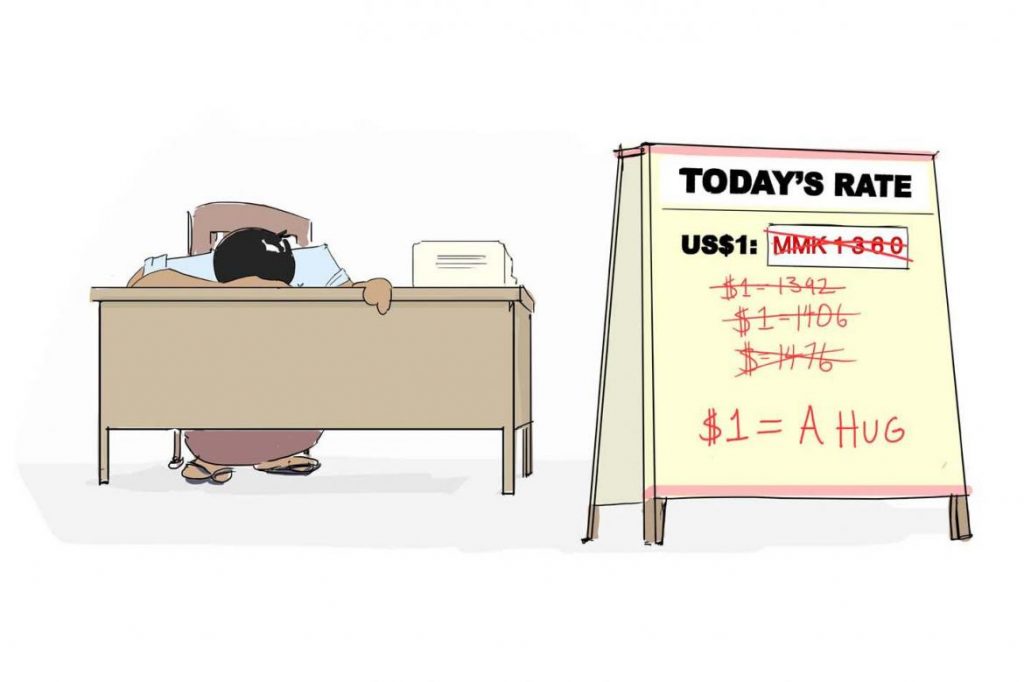Many factors are contributing to the depreciation of the kyat and halting the slide will be a big challenge for the government.
By SITHU AUNG MYINT | FRONTIER
THE KYAT HAS been falling in value against the US dollar in recent months. On July 25, it slumped to K1,427, its lowest point for the year, at authorised foreign exchange dealers. This was down from K1,300 to the greenback in early June. The depreciation of the kyat against the dollar came as the US currency appreciated against other currencies on international markets. It’s not so much of a problem if the dollar is rising in value on international markets. But if it is because of the weakness of the kyat, it’s a problem for many sectors of the economy. A stable kyat is important for Myanmar’s economic development.
On June 11, the exchange rate was K1,344 to the dollar, and the buying price was K1,346. This means that between June 11 and July 25, the kyat had depreciated by 6.2 percent against the dollar. Such a fluctuation in less than seven weeks can be described as significant. During the same period, the kyat also depreciated by 5.4 percent against the euro, 4.5 percent against the Singapore dollar, 3.2 percent against the Malaysian ringgit and 1.8 percent against the Thai baht. This shows that the kyat is losing value against currencies other than the greenback. The average fall in value is 3 percent, which is not insignificant. The depreciation of the kyat has tarnished the record for currency stability that the National League for Democracy government had achieved since it took office more than two years ago.
Financial data for 2017 shows that the kyat enjoyed a stable exchange rate against the dollar, beginning the year at K1,358-K1,362 and ending it at K1,352-K1,354. On August 1 last year, it was trading at a range between K1,354 and K1,356. The stability of the exchange rate last year was due to a range of factors, including a stable greenback on international markets, a balance between revenue and spending in the government budget, and a money supply appropriate to the financial situation. Another factor was the Central Bank of Myanmar’s effective management of the foreign exchange market.
To ensure that the value of the kyat is kept at an appropriate level, the budget deficit and trade deficit need to be kept at manageable levels. Foreign investment must continue to flow in, and deficits should not be financed by the printing of money, which is inflationary. The Central Bank also needs to prevent the manipulation of the money market by powerful players in the economy, such as private banks.
Support more independent journalism like this. Sign up to be a Frontier member.
Let’s consider the present situation. The budget for the fiscal year beginning on October 1 anticipates estimated revenue of K20 trillion and spending of K24.9 trillion. Of the nearly K5 trillion deficit, the Central Bank is expected to cover only 20 percent.
Foreign trade figures for the 2016-17 fiscal year showed a deficit of $5 billion from exports worth nearly $12 billion and imports valued at $17 billion. In 2017-2018, exports were worth $14 billion and imports, $18 billion, leaving a trade deficit of $4 billion. The figures are from the government and do not include illegal trade.
Minister for Planning and Finance U Soe Win has set a target for exports and imports worth about $15 billion each in 2018-2019, and a trade deficit of about $500 million. A big reduction in imports has also been proposed. The inflation rate was 5.5 percent last year and Soe Win has promised that in 2018-2019 it will be about 5.9 percent.
With these factors at play, there should be no reason for further significant falls in the value of the kyat or for it to be affected by instability.
As for the recent slide in the kyat against the dollar, the main causes are likely to include a fall in the value of exports, a decline in the illegal export to China of commodities such as rice and sugar, reduced foreign direct investment, and a weakness in supervision by the Central Bank.
One concern is that if the value of the kyat continues to fall, people will be encouraged to buy foreign currency, which will exacerbate the situation.
If the NLD government is unable to attract more FDI, if there is a revenue shortfall in the budget, if exports do not increase, and if the Central Bank is unable to take more steps to control the foreign exchange market, the slide in the value of the kyat is likely to continue.







